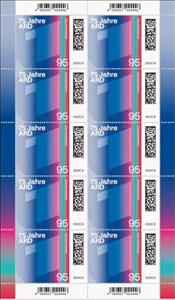Full Pane: ARD Public Broadcaster, 75 Years (Germany, Federal Republic 2025)
ARD Public Broadcaster, 75 Years (Germany, Federal Republic 2025)
05 June (Germany, Federal Republic ) within release ARD Public Broadcaster, 75 Years goes into circulation Full Pane ARD Public Broadcaster, 75 Years face value 10*95 Euro cent
| Full Pane ARD Public Broadcaster, 75 Years in catalogues | |
|---|---|
| Michel: | Mi: DE 3911KB |
| Colnect codes: | Col: DE 2025.06.05-01a |
Full Pane is vertical format.
Integrated ground perforation S.Also in the issue ARD Public Broadcaster, 75 Years:
- Stamp - ARD Public Broadcaster, 75 Years face value 95;
- Full Pane - ARD Public Broadcaster, 75 Years face value 10*95;
Full Pane ARD Public Broadcaster, 75 Years it reflects the thematic directions:
An anniversary is the date on which an event took place or an institution was founded in a previous year, and may also refer to the commemoration or celebration of that event. For example, the first event is the initial occurrence or, if planned, the inaugural of the event. One year later would be the first anniversary of that event. The word was first used for Catholic feasts to commemorate saints. Most countries celebrate national anniversaries, typically called national days. These could be the date of independence of the nation or the adoption of a new constitution or form of government. The important dates in a sitting monarch's reign may also be commemorated, an event often referred to as a "Jubilee".
The Australian Broadcasting Corporation (ABC) is Australia's principal public service broadcaster. It is funded by grants from the federal government and is administered by a government-appointed board of directors. The ABC is a publicly-owned statutory organisation that is politically independent and accountable; for example, through its production of annual reports, and is bound by provisions contained within the Public Interest Disclosure Act 2013 and the Public Governance, Performance and Accountability Act 2013, with its charter enshrined in legislation, the Australian Broadcasting Corporation Act 1983. ABC Commercial, a profit-making division of the corporation, also helps generate funding for content provision.
A number is a mathematical object used to count, measure, and label. The most basic examples are the natural numbers 1, 2, 3, 4, and so forth. Numbers can be represented in language with number words. More universally, individual numbers can be represented by symbols, called numerals; for example, "5" is a numeral that represents the number five. As only a relatively small number of symbols can be memorized, basic numerals are commonly organized in a numeral system, which is an organized way to represent any number. The most common numeral system is the Hindu–Arabic numeral system, which allows for the representation of any non-negative integer using a combination of ten fundamental numeric symbols, called digits. In addition to their use in counting and measuring, numerals are often used for labels (as with telephone numbers), for ordering (as with serial numbers), and for codes (as with ISBNs). In common usage, a numeral is not clearly distinguished from the number that it represents.



